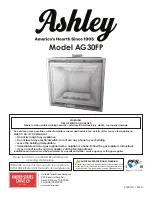
COMBUSTION AIR
WARNING: USE THE AIR INTAKE DAMPER FOR ADJUSTING COMBUSTION INLET
AIR ONLY! OTHER METHODS OF RESTRICTING OR BLOCKING COMBUSTION
INLET AIR ARE STRICTLY PROHIBITED!
(See Figure 1)
Figure 11A
Stove Air Inlet Connection
1. It is recommended that the stove be connected to an outside source of combustion air to
improve stove performance. Flexible metal hose, such as ClevFlex, or rigid metal pipe,
(conduit), must be connected around (NOT INSIDE) the combustion air inlet tube (Figure
11A). Be careful not to pinch or bend the outside air pipe with too small a radius which may
e terminated flush with the outside wall but should be protected from wind and weather by a
hood. Note: The outside air pipe must terminate above the maximum snow line.
2. 2. Outside air may be drawn from a semi-enclosed attic or crawl space or any semi-enclosed
space. Take care not to draw cold air past water pipes that may freeze.
3. 3.Increase the outside air pipe diameter to 3” for runs over ten (10) feet and elevation over
4,000 feet. Note: Long runs should be avoided.
4. Terminate the outside air pipe below the exhaust vent outlet.
5. 5. An open mesh screen should be placed over the outside air pipe opening to prevent birds
or rodents from nesting in the opening. Use an elbow or shield to prevent prevailing winds
from blowing directly into the outside air intake pipe. NOTE: Mesh screen should be no
smaller than one-fourth inch (1/4”) by one-fourth inch (1/4”).
6. In the case of a sealed fireplace insert shroud, an outside air inlet to the fireplace cavity is
necessary to ensure adequate airflow for combustion.
WARNING: OUTSIDE COMBUSTION AIR IS REQUIRED FOR ALL MOBILE HOME
INSTALLATIONS!
Pepin installation manual
Page 14










































